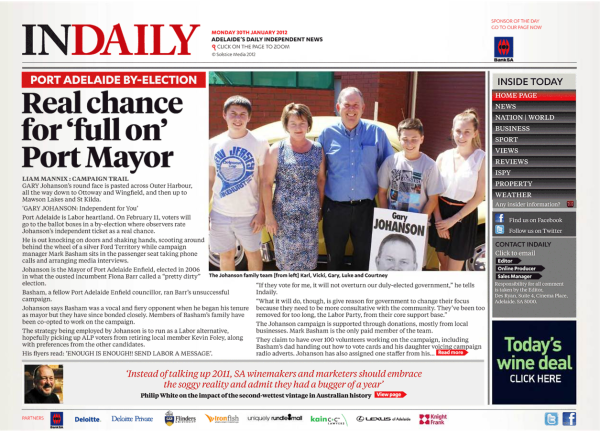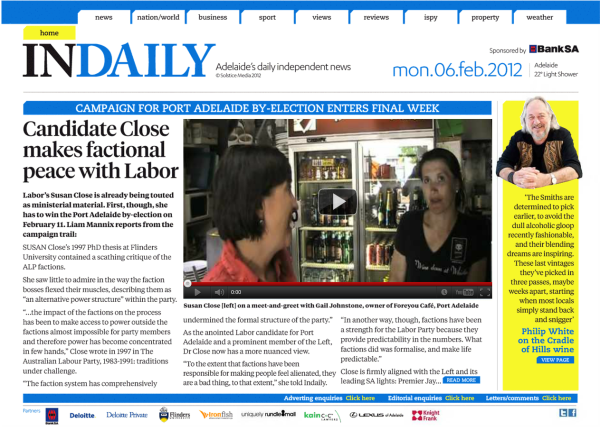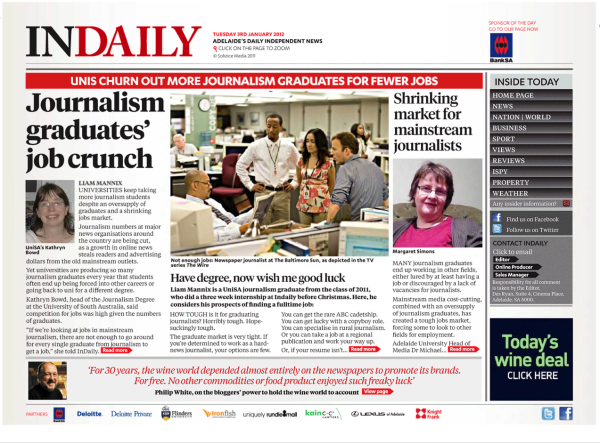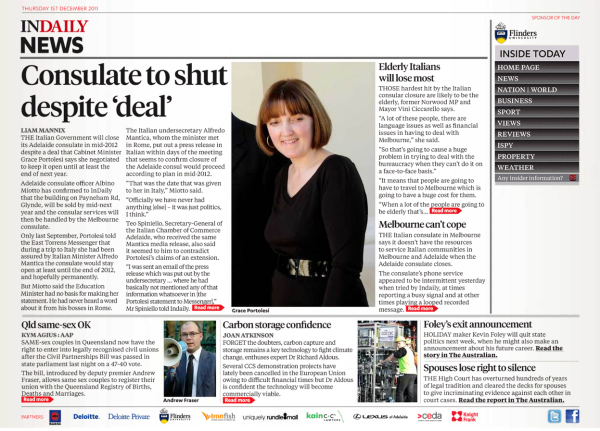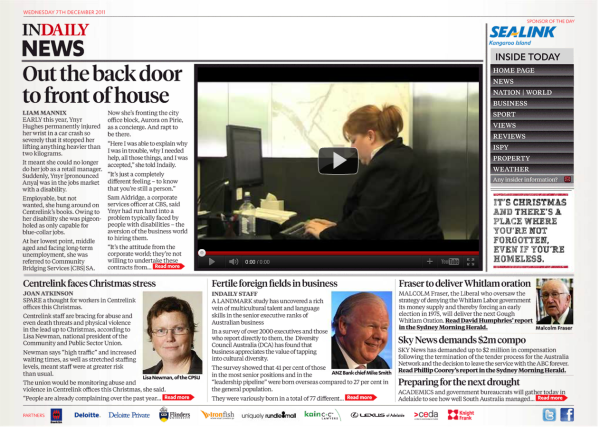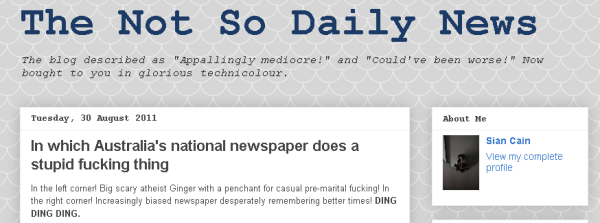en conclusion
BoyJournalist has finally come to an end.
Well, it came to an end at the start of March, but I’m only updating you, internet, now.
As blogged on here, Indaily offered me three months of relief work covering for another journalist. That kept getting extended and extended… until it was made permanent at the end of February.
I’ll be working atIndaily as a cadet journalist for the next 6 months, and then I’ll get my grading.
Indaily is exactly where I want to be in this stage in my career – it’s better than I dared hope for upon concluding my degree those many months ago. I get to work with some of the best journalists in the state – immensely experienced and talented teachers. And it’s fast-track learning; I’ve been thrown right into the deep end reporting on important issues, filing serious stories. It’s been very difficult so far, but I think if I survive it I’ll come out at the end a solid journalist.
So that’s the end of BoyJournalist as we know it. A few stats from the journey:
52 published posts
6270 views
57 comments
most popular post: The TV News Cheat Sheet
a selection of the most popular google search terms: Liam Mannix, jeannie cako, stress experienced by journalism students, bernard tomic underwear, “metaphysics and douchebags” (sic), is it hard to get a job as a journolist in adelaide (sic), what underwear does bernard tomic wear?, not cut out to be a journalist, what does bernard tomic eat, why do i refer to myself as we, ian mannix edd’s fruit and veg, smear campaign against hitler, have a cricky day means, boys skp cam piee,
Two major pieces of writing
Being employed by InDaily has been a blast. It’s enormously reassuring to know that the career you’ve studied for, the one you’ve had your heart set it on, is actually awesome. (so far) It’s been everything I thought it would be. It’s been challenging and competitive and difficult and exciting. The thing I’ve loved most since I started working at the ABC as a producer is the thrill of the chase; knowing a story’s there, or a difficult but important talent exists, and working to find it. At InDaily, I’ve had a chance to do that.
The other nice thing to confirm is that, hey, I’m actually alright at this journalism business.
During the last three weeks at InDaily, I completed two major pieces of writing, of which I’m quite proud.
The Port Adelaide byelection was on Febuary 11; it resulted in a 9.9 per cent swing against the incumbent ALP candidate. It always looked a reasonably close (and very interesting) election. The seat was held by Kevin Foley, an unpopular retiring member; he was Mike Rann’s treasurer when that leadership was at both the peak and nadir of its popularity. Port Adelaide is a safe ALP seat; some commentators have called it ‘Labor heartland’, although that’s a contentious label.Foley suffered a double-digit swing against him in the last election, but so safe was the seat he still held it with a 12.8 per cent margin.
To make the game more interesting, Mr Foley’s preselected replacement, Susan Close, found herself running against an independent – the Liberal party decided against endorsing a candidate, believing that would help their chances of getting an independent over the line. Gary Johanson, a popular (some might say populist) local Mayor running as a Liberal-leaning independent would be Close’s major competition. Adelaide Advertiser polling showed Mr Johanson would make a close race of it.
As readers of this blog will note, I’m a regular reader of longform.org – longform political profiles particularly interest me. I suggested to my editor that perhaps I could work on two feature profiles of the major candidates. I’d take a week to research and write each one, conduct long interviews with each (I spent a day with Mr Johanson, and 2 hours with Mrs Close) and see how much I could dig up about them. He bought the idea, and off I went.
Hit the image to go to the story. Both ended up running on the front page
On Tuesday the 3rd of January, I had three articles across the front page of that day’s InDaily – 2 stories and an opinion piece.
Hit the image to go to the paper, or click the links for individual stories.
Journalism graduates job crunch
Have degree, now wish me good luck
Shining market for mainstream journalists
Work Experience at InDaily
After four years of study, I’ve graduated. It’s a funny feeling. I’m keen to get into, you know, being a journalist. And I’m going to miss my university friends and lifestyle. I guess it’s sorta like primary school, high school and uni – it sucks for a few years, but then as you build friendship networks it becomes amazingly awesome.
The biggest thing about graduating, though, is the uncertainty. From primary school you head to high school, and then to university – but after graduation, there’s an enormous amount of uncertainty because of the vast number of possible paths your life can take. That uncertainty, even if you’re confident of finding a good and fulfilling job to start you on a good and fulfilling career, is not so nice.
Anyway. For two weeks in December (post graduation) I interned at the InDaily, an online-only newspaper based in Adelaide but serving South Australia. The paper is edited by Des Ryan – recently shortlisted for Crikey’s editor of the year (paywalled, but worth the subscription).
It’s been pointed out to me the paper is called InDaily, and that is not a shortening of Independent Daily, but is in fact the full title. Post has been updated to correct that.
The two weeks I spent were fantastic. Many places you intern at don’t expect much of you, and don’t let you show what you can do – it’s formulaic. InDaily was different – from day 1, I was treated as a (junior, inexperienced) journalist, given stories at the morning’s conference, and expected to hit my deadline. It was fantastic.
STUDENT JOURNALIST TIP
Interested in interning at one of the most dynamic media players in Adelaide? Get in touch with Des Ryan, the editor of InDaily, and enquire about work experience
After the two weeks, to my great delight Mr Ryan generously offered me a few more weeks relief work early in 2012 – a start I really hope to build on. I’m happy to work anywhere, but InDaily seems like an ideal place to start a career. You get to work with experienced, high quality journalists, and sit right next to the editor who subs your work – a great learning experience.
Anyway, below are a few samples of text and video stories I put together while at InDaily. Click on the images for a link to the pages, or link directly to the stories using the links
Consulate to shut despite ‘deal’
Elderly Italians will lose most
Normal
0
false
false
false
EN-AU
X-NONE
X-NONE
MicrosoftInternetExplorer4
/* Style Definitions */
table.MsoNormalTable
{mso-style-name:”Table Normal”;
mso-tstyle-rowband-size:0;
mso-tstyle-colband-size:0;
mso-style-noshow:yes;
mso-style-priority:99;
mso-style-qformat:yes;
mso-style-parent:””;
mso-padding-alt:0cm 5.4pt 0cm 5.4pt;
mso-para-margin-top:0cm;
mso-para-margin-right:0cm;
mso-para-margin-bottom:10.0pt;
mso-para-margin-left:0cm;
line-height:115%;
mso-pagination:widow-orphan;
font-size:11.0pt;
font-family:”Calibri”,”sans-serif”;
mso-ascii-font-family:Calibri;
mso-ascii-theme-font:minor-latin;
mso-fareast-font-family:”Times New Roman”;
mso-fareast-theme-font:minor-fareast;
mso-hansi-font-family:Calibri;
mso-hansi-theme-font:minor-latin;
mso-bidi-font-family:”Times New Roman”;
mso-bidi-theme-font:minor-bidi;}
Anyway. For two weeks in December (post graduation) I interned at the Independent Daily, an online-only newspaper based in Adelaide but serving South Australia. The paper is edited by Des Ryan – recently shortlisted for Crikey’s editor of the year (paywalled, but worth the subscription).
Journalists as collaborators rather than leaders

Update: Sharon emailed me to let me know of quite a lot of basic errors in this post, which have now been corrected. Sorry Sharon!
Had a very interesting Advanced News Writing lecture from Sharon Mascall (@sharonmascall)- who’s just been nominated for a Walkley Award for ‘The Big House’, a radio doco on the Port Augusta Jail. You can listen to it on the BBC’s excellent, non-geo-blocked iPlayer here. Sharon currently works as a producer for the BBC’s The World Today, has worked for the BBC World Service’s ”Europe Today’, and her documentaries have aired on several World Service doco slots including ‘Heart and Soul’ and ‘The Friday Documentary’. She’s also worked for Outlook and The Strand.
Oddly enough, the lecture actually focussed on social networking. Sharon made a range of really interesting points, but the one that really caught my interest was the idea of a journalist as a collaborator.
Here are my iPad notes from the lecture:
Audiences don’t want to receive or comment on the news, they want to own it and contribute to it. Where does this leave the journalist? Are we collaborators? Leaders of collaborative groups?
Journalists should allow stories to be driven by the response – be willing to follow up
Remember though that traditional news values still apply
Sharon was suggesting that by allowing audiences to interact with content, we’ve given them a measure of ownership (it’s called buy-in in management parlance) over it. When you’re trying to get a group of people to accept and act on an idea, you try to make them contribute to its formation; they feel a part of it, and then they feel that it’s their idea, and they’re more motivated to implement it.
Same thing happens with news. Once we start engaging with news – comments on articles at first, but more significantly using soc media to debate the news, and talk about it with others, and best-case talk about it with the author or people relevent, we start to own the news.
The idea of audiences exercising ownership over content has a whole range of really interesting implications.
Firstly, it’s going to make audiences better consumers. People will be more engaged with content, more interested. That’s good for society, because people are more informed and thus make more informed (and thus better) decisions.
The active consumer won’t accept incompetence on the part of the journalist (Sharon touched on this too). The active consumer feels invested in the story, so they won’t accept mistruths. The active consumer doesn’t accept the journalist getting it wrong.
And theoretically, it should make news content more saleable. From point 1 – more buy in means more engagement, which theoretically means more loyalty and therefore more demand.
A very rough, unfinished first draft – feature writing, and #longform sports journalism
 My favourite class in the second semester of 2011 (my last) would be Advanced News Writing. Not all bits are super compelling, but I’m loving the feature writing we get to do.
My favourite class in the second semester of 2011 (my last) would be Advanced News Writing. Not all bits are super compelling, but I’m loving the feature writing we get to do.
I’d love to be a feature writer at some point in the future. I don’t think it’s a realistic short term goal, simply because a) I’m not yet a good enough, nor experienced enough, writer, and b) it’s very hard to find entry level feature writing work. None-the-less, it’s a hobby and a passion.
I think finding longform.org and instapaper.com really got me into longform journalism (features). One is an incredible resource, the other allows me to read all of the stories on my iPad. Oh, and I subscribed to The Best of Journalism, a weekly newsletter filled with great reads ($1.99 a month).
Our first in-class assignment (not for marks, I think) was to write a rough draft feature article of any length within 2 hours, using quotes stolen from other articles (a very rough draft).
I chose to put together an article I’d been toying with for some time –
BERNARD TOMIC NEEDED TO LOSE THE AUSTRALIAN OPEN AND HE DID
And he probably still needs to lose the Australian open. Because if he wins, his career may be destroyed.
Novak Djokovik serves the ball very hard. He flicks it upward with his left hand, tilts his wiry frame backward, watches the golden orb perscribe a gentle parabola in the air, then thwacks it over the net, aiming at the spot where the white lines of the court come together. The ball kisses the turf, kicking up a tiny puff of paint, whizzes past Bernard Tomic, and buries itself in the dark green foam padding behind him.
The Australian is unfazed. The match is currently tied at one-all in the third set, with Djokovic serving. The score, the final arbitrer in competitive sport, says Bernard Tomic is perfectly, exactly the equal of a man ranked number 3 in the world. Maybe Bernard was even feeling confident. Later in the year, about to play Rafael Nadal, he told a reporter he thought he could win. “Oh, I believe so. I believe so. I mean, you know, it’s an opportunity that I get. He’s the world No. 1. I’ll just have a go.” Maybe he’s thinking the same thing as Djokovic readies himself for another serve. Poised right at this point, the match can go either way. So can Bernard Tomic’s career. And to thrive, he needs to lose.
image from Not Enough Megapixels on Flickr
Bernard Tomic is “the great white hope of Australian tennis”, say the newspapers. It’s unclear why his skin color is important; perhaps it isn’t. According to The Age, “his star is born”, which perhaps suggests a rebirth – having gestated for 18 years in the womb of competitive tennis, he is now no longer a child of his mother Ady but a child of the Australian people. Patrick Smith writes in the Australian that we don’t rent or lease our sports stars from their mothers; we take ownership, wholelly and completely. Bernard is the son of the Australian public now, whether Ady likes it or not, and like all children he represents hope for the future.
Bernard’s parents migrated Queensland via Germany and Croatia in 1995, his father taking up work driving taxis. As with many migrant families, the child Bernard represented a new beginning. He was an Australian citizen, not a migrant, and would enjoy all the privelidges and opportunites that citizenship entailed him to. He’s fluent in his mother tounge, like all good migrant children. His father, John, his coached him since age 8. He drives him hard. But with that defeat to Djokovic, Tomic has revealed to Australia just how good he might oneday be. And so he cannot be allowed to be Bernard Tomic, son of John and Ady Tomic, any longer. Now, he is Bernard Tomic, great white hope.
Should Tomic come to fulfil his early promise, he may become the next great Australian tennis player, a role which has been vacant since Pat Rafter retired in 2004. His unmissible potential has made him a drawcard in Australia, where his performance now dominates papers. At 19, his fame has eclipsed those around him, such as Chris Guccione and Marinko Matosevic. Casey Dellaqua and Anastasia Rodionova are anonymous, and Sam Stosur can’t maintain interest because she is a woman. Lleyton Hewett, the petulant embarresment of Australian sport, briefly tolerated because of his brief success, has been relegated from the spotlight.
The great thing about potential is it has a worth even if unrealised. Precious metals are valueless until you dig them from the ground and put them to use – but potential can far better capture the imaginations of fans than relalised talent. Obvious potential, lauded by the media, allows the sports fan a blank canvas upon which to paint. Bernard Tomic could become anything.
However, as players age and potential starts to become realised – or not – crowds expect results. More problematically for young players, good performances set bars over which they are continually expected to vault. If Bernard Tomic had won Wimbledon, his bar would have been set impossibly high. He would have revealed too much of his potential. He’d be required to be competitive in every clash with a top-ranked player. And he would expose himself to that most horrible of emotions, disappointment. His every match would be ranked and compared with the one before and the one before that, and where those events did not neatly plot out an ascending line he would be scolded and chastened. Disappointment, particularly the disappointment of parents, is the worst of emotions because you know you’ve broken a trust. Bernard is at a crucial point in his career – he has the ability to go further, but must learn to cope with the increasing pressure of public expectation. His career may yet follow that of Pat Rafter’s, who reached such a high pinnicle of public adulation that he now models underwear. Or he could become the next Mark Phillipouses.
MARK PHILLIPOUSES IS SO DISSAPOINTING THAT HE STARRED ON A REALITY SHOW ABOUT DATING OLDER WOMEN.
Like Bernard – and like so many Australians – Phillipouses was the son of a migrant. His father, Nick, hails from the Greek island of Tinos, a tiny shard of rock in the Aegean Sea. Like Bernard’s dad, he coached his son from age six, tossing tennis balls at him on a suburban court in Melbourne.
Phillipouses was a junior champion like Tomic, going pro at 18. At 19, he was in the top 50. At 20, he beat Pete Sampras in the 3rd round of the Australian Open. He was a man with potential. At 22, he reached his first Grand Slam final, losing the US Open, and then a year later won the Hopman Cup and entered the world’s top 10. And then he dropped out.
At that stage of Mark’s career, the weight of expectation was at it’s highest. Australian sports fans are fickle, and tend to gravitate en masse to sports in which an Australian is dominant. Rafter’s decade of success had drawn new eyes to the game, and as he came to the end of his career, his performances dropping away correspondingly, there was a surplus of hope in the sport, an incorporal energy that lacked a body. Phillipouses became that body, and it destroyed him.
In nearly every interview, Phillipouses says he needs to relax more, that he’s too hard on himself, that he’s too hungry. But those sound more like things Phillipouses wants to see in himself, rather than qualities that are already there. The reality is, Phillopouses isn’t a driven player. His ideal day? “I’d wake up late, have my pancakes, see my dogs, hang out with my dogs a little bit, swim in the pool, friends will come over, we’ll go wake boarding for a few hours, come back, jump on the bikes, go down to the beach, go eat some sushi, come back, wake board, come home have a bit of a sleep, wake up, go nightclubbing and do it all over again.” He prepares for a match only half an hour before it begins. He was not a man well equipped to deal with expectation. In 2004, a journalist told him the public expected more aces from him. He didn’t have an answer.
BERNARD TOMIC STILL HAS A CHANCE TO HAVE A GOOD CAREER. He didn’t win Wimbledon, and he probably won’t win the Australian Open. His early successes have given him a taste of the weight of expectation, and hopefully he will grow comfortable with that weight before attempting to add to it.
Phillipouses is now an irrelavence, more reality TV star than real tennis player. He starred in Age of Love in 2007, eventually choosing Amanda Salinas as his ideal partner. The show was not reknewed.
A few more great journalism student blogs
Spotted this the other day – The Not So Daily News, which is a jblog from a peer of mine at UniSA, Sian Cain. Its 3 posts deep and looks pretty good.
The author wrote a fair bit of stuff for us at UniLifeMag (you can find her on the site’s archive at unilifemag.com), and in my opinion was our funniest writer (with apologies to Angus Randall).
Anyway, check her out. I do have to point out here that it’s built on the blogger platform, which I’m not a fan of – less graphically appealing than wordpress, and they stick a nasty nav bar across the top. Although I’m sure Sian disagrees.
EDIT
Sian got in touch (in the comments at the bottom) to point out that her blog has been migrated to a shiny new wordpress home – http://thenotsodailynews.wordpress.com/ . It’s much nice.
If you’re in the mood for some good journalism student blogs, have a look at
Shiny Journalism
This is a very infant blog by a classmate of mine. He promises to put things up. We shall see.
Wannabe Hacks
this is the coolest thing I’ve come across in ages – a journalism student group blog. It’s based in the UK, home of everything wonderful. I wonder if the idea was suggested to them by their teachers, or if they came up with it themselves? At any rate, it’s really taken off, and should result in employment for the authors – the ultimate aim.
Random Trivia: This blog was originally called Hack-to-Be, but Dad made me change it to something “less negative”
oh, and don’t forget to check out the progress of the other journalism student blogs linked to on the right!
know of other great jblogs? let everyone know in the comments
Upward Progression – My Newsreads at ABC Port Pirie
I’m working hard on developing a broadcast voice. I hope to be a broadcast journalist for the ABC one day, and having a quality voice is an integral part of that.
The ABC offers a lot of voice training for its journalists. The voice coach ISDNs into all the regionals once a week to work on the voices of the regional journos. So once you’re in the system, you’re going to improve a lot. For someone hoping to break in, it’s a matter of a) showing I’ve worked at my voice, and b) having a voice which falls into the category of ‘could be trained’.
To that end, I’ve been working a lot on my voice. Getting a chance to read the 8.30 and 9.30 heads on air at Port Pirie was a big help (I just came off another 3 week stint producing up there). I also made time to watch the journos up there do their reads, plus asking them for advice.
Some of their/my thoughts:
– resonance is important. I concentrated on getting resonance through the top of my nose, and the bottom of my chest
– strong authority in the voice. I don’t think I have this, my voice is to croaky, but I was told my authority wasn’t bad
– one of the most interesting tips: consider how you tell your audience that a story is ending. The final sentance in a story should be slower and have a lower intonation, to signal the end to the audience
– I started by hunching over my microphone to allow my voice to get deeper, but was told this wasn’t the way to go because it placed the wrong angle on the vocal cords. Head needs to be back
– I squeezed my core muscles to get the depth into my diaphragm, but not sure that made much difference
please note those notes shouldn’t be taken as instructional, because I haven’t had much real training. Just my attempt to imitate what I was hearing others do.
Anyway, below you can find several of my newsreads from Pirie, in chronological order. To return to point a) made earlier, the thing I’m most pleased with is that there’s evidence of continual improvement in these reads. But still a long way to go.
July 18 – 10:30 Heads
July 21 – 9:30 Heads
July 21 – 10:30 Heads
July 25 – 9:30 Heads
July 25 – 10:30 Heads
July 26 – 9:30 Heads
July 26 – 10:30 Heads
July 27 – 9:30 Heads
July 27 – 10:30 Heads
My first hosted segment… sorta
Working down at the lovely ABC Port Pirie (detailed here and here), I got a chance to host a small 5 minute segment of Ann Jones’ morning show. Host? Perhaps not the right word, because it doesn’t really compare to what Ann, the actual host, does. But I got to sit in the studio and ask questions of a studio guest! Which is kinda cool.
Producing the show is a fairly hectic job, and at ABC891 (where I’m employed as a casual producer) we spend all our time controlling the flow of the show. So to be told that I needed to neglect that job for 5 minutes to run into the studio and host a segment was a little worrying. But things are very different in a regional studio – the presenter handles all the technical producing, which is a big task. Normally, presenters get two producers – one on the phones/screen comms, and one handling technical ie. levels, cartstack, mixing.
Having less people working on a show means that each has to do more – meaning producers often go to air, either with prerecords or live. In this case, every Friday the regular producer presents a 5 minute AFL segment, interviewing a Champion Data statician, and giving a preview of all that week’s AFL games.
And, on the 21st of April, I presented the segment.
Adelaide High Rowing Video – by me
I was recently contracted (voluntarily contracted?) to put together a video for Adelaide High School’s rowing program.
The footage was all taken by other people, on a small non-HD camcorder. The work flow was very strange – I was presented with hours and hours of random footage, taken by many different people, at varying times of day, of different activities, and of different qualities.
Turning that into a video with a coherent narrative wasn’t easy. Its sort of built around a rowing workflow – train, prep, race, go home. The cuts are taken from very large videos, most of which were unusable. I went through and picked out the accidentally useable stuff, and the accidentally artistic shots.
I’m not sure how good it is, but apparently the kids liked it – and if the client likes it, nothing else really matters.
